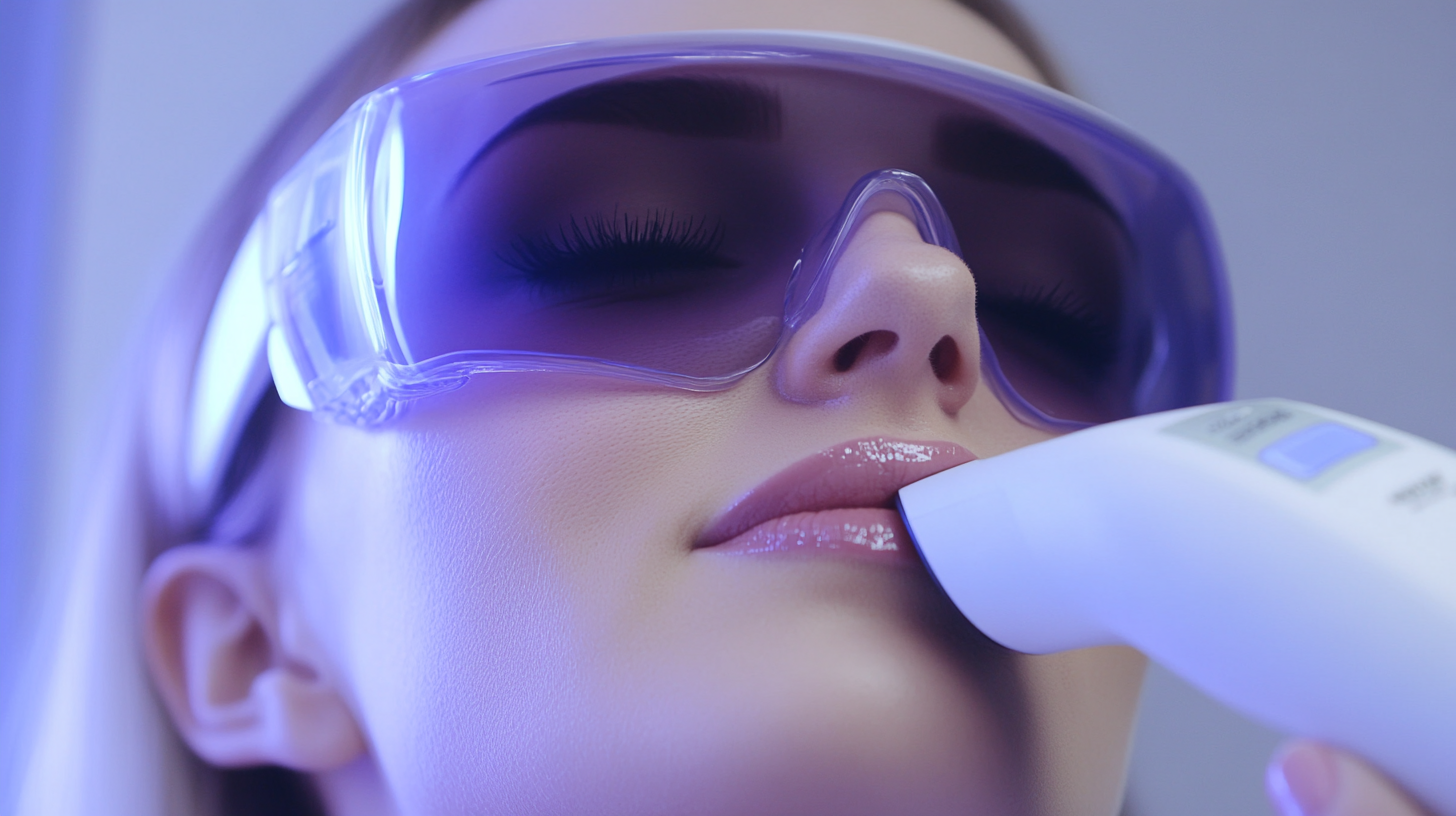Emerging Trends in Best Laser Hair Removal Solutions for 2025
 As the global demand for effective and long-lasting cosmetic solutions continues to rise, the laser hair removal market is projected to reach approximately $1.5 billion by 2025, growing at a staggering CAGR of over 15%. This growth is primarily driven by increasing consumer awareness, advancements in technology, and the rising popularity of aesthetic treatments. Notably, China is emerging as a key player in this market, leveraging its manufacturing prowess to provide cutting-edge laser hair removal devices. With innovations such as diode lasers and advanced cooling systems, the efficiency and safety of treatments are significantly enhanced, ensuring optimal results with minimal discomfort. As we look ahead to 2025, the landscape of laser hair removal solutions will undoubtedly be shaped by these trends, positioning China at the forefront of the global aesthetic industry.
As the global demand for effective and long-lasting cosmetic solutions continues to rise, the laser hair removal market is projected to reach approximately $1.5 billion by 2025, growing at a staggering CAGR of over 15%. This growth is primarily driven by increasing consumer awareness, advancements in technology, and the rising popularity of aesthetic treatments. Notably, China is emerging as a key player in this market, leveraging its manufacturing prowess to provide cutting-edge laser hair removal devices. With innovations such as diode lasers and advanced cooling systems, the efficiency and safety of treatments are significantly enhanced, ensuring optimal results with minimal discomfort. As we look ahead to 2025, the landscape of laser hair removal solutions will undoubtedly be shaped by these trends, positioning China at the forefront of the global aesthetic industry.
Challenges in Current Laser Hair Removal Technologies and Their Solutions
As we navigate the advancements in laser hair removal technologies, several challenges remain prevalent within the industry. One significant issue is the varying skin tones and hair types among individuals. Traditional laser systems often struggle to effectively treat individuals with darker skin or lighter hair colors, leading to uneven results or increased risk of skin damage. To address this, emerging technologies are incorporating multi-wavelength lasers that offer customizable settings, thereby enhancing efficacy across diverse skin and hair types.
Another challenge lies in the discomfort and downtime experienced during and after treatments. Many clients report pain and side effects like redness and swelling, which can deter them from committing to full treatment regimens. Recent innovations are focusing on the integration of cooling systems or advanced pain management solutions that minimize discomfort. Additionally, the development of faster laser pulses and handheld devices promises to reduce treatment times significantly, making the process more convenient and appealing for users in 2025. These advancements not only improve the overall patient experience but also set a new standard for efficacy and safety in laser hair removal.
The Role of Regulatory Standards in Ensuring Quality and Safety
The role of regulatory standards in the laser hair removal industry is becoming increasingly vital as we approach 2025.
With the rise in consumer demand for effective and safe hair removal solutions, regulatory bodies are stepping up to ensure that these procedures meet high safety and quality benchmarks. Recent trends indicate that adherence to stringent quality management system regulations is essential for manufacturers and service providers in the beauty industry. Effective regulatory frameworks can help mitigate risks associated with laser treatments, thereby enhancing patient safety and satisfaction.
As highlighted by the FDA's updates to medical device quality system requirements, aligning with established standards, such as ISO 13485:2016, can significantly improve product reliability and patient outcomes in the laser hair removal sector.
In fact, statistics show that approximately one in ten patients may face harm due to inadequate safety measures in healthcare settings, a stark reminder of the importance of regulatory compliance. By prioritizing safety and quality through rigorous standards, the laser hair removal industry can foster public trust and drive innovation, ensuring that advancements in technology do not compromise patient welfare.
Emerging Technologies: Innovations Shaping the Future of Hair Removal
The future of hair removal is being significantly influenced by innovative technologies that promise to enhance efficacy and user experience. As we move towards 2025, advancements such as advanced laser systems and artificial intelligence are paving the way for more personalized treatments. According to a report by Research and Markets, the global laser hair removal market is expected to grow at a compound annual growth rate (CAGR) of 16.1% between 2021 and 2026, indicating a strong shift towards these emerging solutions.
One notable trend is the use of cooling technologies integrated within laser devices, designed to enhance patient comfort during treatment. A recent study published in the Journal of Cosmetic Dermatology highlights that these innovations reduce skin temperature, improving safety while maintaining treatment effectiveness. Furthermore, AI-driven diagnostics are enabling providers to customize hair removal procedures based on individual hair and skin types, resulting in more efficient and tailored outcomes. As these technologies continue to evolve, they are set to redefine the landscape of hair removal solutions, making them more accessible and effective for a broader audience.

Patient-Centric Approaches: Enhancing User Experience in Treatments
As we look ahead to 2025, the laser hair removal industry is increasingly emphasizing patient-centric approaches that significantly enhance the user experience. This shift aligns with the broader movement in healthcare towards integrating patient feedback into treatment and service design. By leveraging digital health technologies and artificial intelligence, clinics can gather real-time insights from patients, enabling them to tailor treatments that meet individual needs and preferences.

Tips for improving patient experience in laser hair removal include actively soliciting feedback through social media and surveys. This can help providers focus on areas that matter most to patients, such as comfort levels during procedures and post-treatment outcomes. Additionally, adopting shared decision-making models empowers patients by ensuring they understand their options and feel involved in their care journey.
Furthermore, streamlining the patient check-in process can pave the way for a more efficient experience. Ensuring that all necessary information is captured ahead of time minimizes delays and allows for a smoother transition into treatment. By placing the patient at the center of the care model, providers can foster a more inclusive and responsive environment, ultimately leading to higher satisfaction and better results.
Sustainability Practices in Laser Hair Removal: A Growing Concern
As we look towards 2025, the conversation around sustainability in laser hair removal solutions is becoming increasingly prominent. Consumers are becoming more aware of the environmental impact of their beauty choices, prompting salons and clinics to adopt eco-friendly practices. These practices include utilizing energy-efficient laser equipment that reduces electricity consumption and waste, as well as implementing proper disposal protocols for harmful materials. By prioritizing sustainability, the laser hair removal industry not only meets evolving consumer expectations but also contributes to a healthier planet.
Moreover, many providers are exploring innovative products that enhance the effectiveness of treatments while minimizing environmental footprints. This includes the use of biodegradable packaging for consumables and sourcing ingredients from sustainable suppliers.
Education plays a crucial role as well; businesses are beginning to train staff on the importance of sustainability in their operations and how to communicate these values effectively to clients. As the demand for ethical and eco-conscious beauty solutions grows, the focus on sustainability in laser hair removal will likely drive not just consumer behavior but also regulatory changes within the industry.
News
- What Can A Professional Skin Care Analyzer Do For Facial Treatment?2025/03/18
Facial treatment (using skincare products or various machines) has been very popular. What can a professional skin care analyzer do for facial treatment?
- What Are Upper Lip Hair Removal Machine Side Effects And How to Avoid?2025/03/13
Lip hairs are very unsightly, especially for female. Other traditional hair removal methods (such as shaving and depilatory creams) unluckily cause more hair.
Products
Inquiry For Price List
For inquiries about laser hair removal, hifu machine, cryolipolysis machine or price list, please leave your email to us and we will be in touch within 24 hours.
Contact Us
- Fanghu West 2nd Road, Huli District, Xiamen City, Fujian Province, China
- sale@bitasbeauty.com























